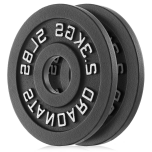When it comes to strength training, weightlifting plates are an essential piece of equipment in any gym or fitness center. Whether you're a seasoned athlete or just starting your fitness journey, understanding the materials used to make weightlifting plates can help you choose the best plates for your needs. Let’s take a closer look at the different materials used in the construction of weightlifting plates.

1. Steel Plates
Steel is one of the most common materials used for weightlifting plates due to its durability and strength. Steel plates are often coated with a layer of rubber or urethane to reduce noise, protect the floor, and prevent rusting. These plates are typically found in commercial gyms, as they can withstand frequent use and heavy loads.
2. Cast Iron Plates
Cast iron is another popular material used for weight plates, especially in more budget-friendly or home gym setups. Cast iron plates are solid, durable, and often come with a simple design. However, they can be prone to rusting if not maintained properly. Some cast iron plates come with a painted or powder-coated finish to reduce corrosion.
3. Rubber-Coated Plates
Rubber-coated plates are essentially either steel or cast iron plates with a durable rubber covering. The rubber coating provides several benefits, including reducing noise when dropping the plates, protecting the floor from damage, and offering a non-slip surface for handling. Rubber-coated plates are also less likely to damage the barbell or other gym equipment.
4. Urethane Plates
Urethane is a synthetic material that is known for its durability, resilience, and ability to withstand heavy use. Urethane-coated plates offer many of the same benefits as rubber-coated plates, but they are often more resistant to abrasion and wear. Urethane plates also maintain their appearance longer than rubber-coated options, making them a popular choice for gyms that prioritize aesthetics.

5. Bumper Plates
Bumper plates, which are commonly used in Olympic weightlifting, are typically made from a steel or iron core wrapped in a thick layer of rubber or urethane. These plates are designed to absorb impact when dropped, which makes them ideal for lifting exercises like snatches or clean and jerks. Bumper plates come in various color-coded options to help athletes quickly identify the weight.
 6. Competition Plates
6. Competition Plates
Competition weight plates are made with a steel or iron core and are precisely calibrated to meet international standards. These plates are often encased in a thick urethane or rubber material. The goal is to provide consistency in weight and size, allowing for an exact match across all plates. These plates are commonly used in professional Olympic weightlifting competitions and training.
Conclusion
Weightlifting plates come in a variety of materials, each designed to serve different needs. Steel and cast iron plates are long-lasting and durable, while rubber-coated and urethane plates offer enhanced protection and noise reduction. Bumper plates are ideal for Olympic lifters, and competition plates are designed for precision
